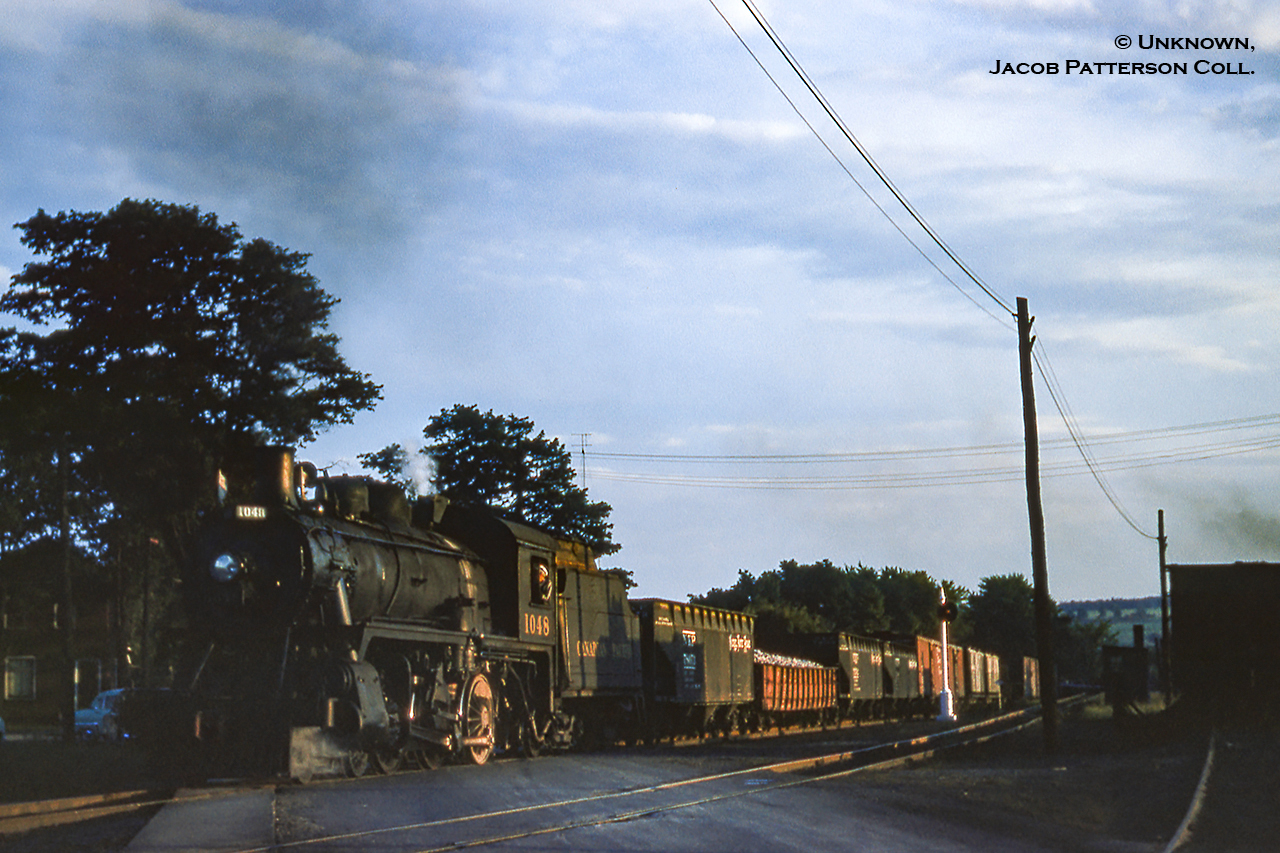|
Caption: CPR extra 1048 (D10h, MLW, Dec. 1912) is seen pulling through Woodstock crossing the long removed Givins Street railway crossing on the St. Thomas Sub. At right is the former engine servicing area for the local branch line assignments. In barely a decade the servicing area will be filled with diesel locomotives ranging from MLW RS3s to MLW S3s, RS18s, and GMD SW1200RS units. Check out the recent post of Carl Noe’s shot facing the other direction in 2001.
Original Photographer Unknown, Jacob Patterson Collection Slide.
|



That signal there lasted into the 90′s. Very neat photo.
That signal was the approach to the diamond with CN. Decades back, the CN Woodstock Operator controlled the diamond. CP crews radioed the CP Woodstock Operator, who telephoned CN for the route. That signal could display green or clear if the diamond was lined for CP. This was beneficial when taking long trains down the St. Thomas, like the detours in 1973 & 1978. If the signal in this photo was yellow when passed, one had to “sneak up” on the diamond signal, it had a relatively short sight line.
Neat. Thanks for the info Ron.
Darn, I wish that signal was still there.
What happened in 1973/1978 to necessitate detours?
And what was re-routed at the time?
In 1973, CP clerks staged rotating strikes. Train crews wouldn’t cross the picket line. In my case I was working a Woodstock job & we would show up for our 1830 Roadswitcher assignment & if the picket line had gone up, we’d turn around & go home. Eventually the entire railway was on strike (or maybe it was locked out). After we were legislated back to work, C&O had trains backed up all the way from Windsor to St. Thomas. London Pool crews were taken to C&O Southwold yard & brought the trains to Woodstock & thru to Toronto. C%O power & vans were used in most case. A temporary train order Operator was based at St. Thomas to hoop orders to each train. Reverse movements also happened a few times. That was the only time in my CP career that we had meets set up between Ingersoll & Woodstock for other trains. Most trains were 60 to 80 cars long.
In 1978 N&W clerks went on strike at Buffalo if I recall. N&W arranged with CP to haul the trains back & forth between Montreal & St. Thomas. I was in the freight Pool by this time & caught about 6 of these. We would be ordered out of London with engines & van (caboose) and go to St. Thomas where the N&W crews would meet us we’d pull the train off the Wabash Transfer & then take it to Toronto. If we got one out of Toronto, we’d give it to them & run engine & van back to Woodstock & thence to Quebec St. These trains were roughly 80 cars each.In both cases, London crews went on a new day at St. Thomas so if you got one each way, you ended up with 4 trips instead of 2. Power was anything from Sw1200s, to RS-10s, RS-18s, C-424s,GP-35s, F7Bs, but no 6 axle units.
Wild, so CP used own power on these? Would any N&W or C&O power have run though? (Railfan questions, thank you)
To your question Stephen, so far as I know, only C&O power was used in the 1973 detours, but I know for sure, no N&W power was used on the 1978 detours, it was exclusively CP power. There was a photo published in Trains magazine of a C&O U25B leading an eastbound out of St. Thomas headed for Woodstock thence Toronto on CP. It was in one of the 2 part article by Greg McDonnell on GE power, sometime in the 1980s.
The approach to cn signal was relocated to mile 0.5 or so at dundas st. Its much newer and should still be there.